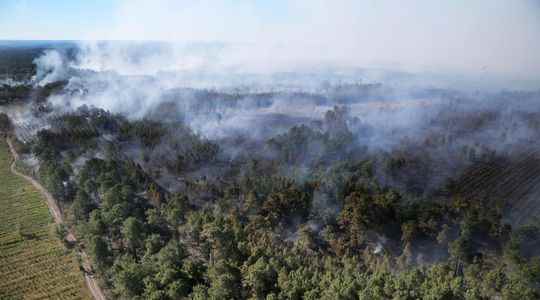Since fires broke out on Tuesday, July 12, in Landiras and Teste-de-Buch, in Gironde, more than 4,200 hectares of forest have gone up in smoke. It’s the first giant forest fire of the summer, and given the predictions of heat waves to come, there’s no doubt that there will be others. Real danger for human beings – more than 6,500 people had to be evacuated from risk areas in Gironde – are the fires really dangerous for the forest area, or does it always manage to rise from its ashes?
We all have in mind images of forests that have become fields of desolation, where only blackened trunks and branches remain on a grayish ground. The green has disappeared, and in view of this observation, one could conclude that no vegetation is able to resist the flames. “If, by resistance, we mean keeping the same tree after the flames have passed, there are actually few resistant species”, explains to L’Express Christophe Chantepy, expert at the Forest Defense Center against fires. at the National Forestry Office (DFCI). “We can nevertheless cite a species, the cork oak, which thanks to the thickness of its trunk is doing better than the others. However, on large fires like that of Gonfaron in 2021 in the Var, many cork oaks burned down.”
Since fire destroys almost everything in its path, the strength of the forest must be qualified with another term, that of resilience. Nature abhors a vacuum and, sooner or later, always takes back its rights. “In the regeneration process, softwoods are the best”, notes Christophe Chantepy, who cites the Aleppo pine as an example. “The fire will melt the resin from its cones and release seeds, which will fall onto ground clear of competition.” Without saying that fire promotes the perpetuation of the species, it has the merit of not preventing it.
However, several points worry the National Forestry Office. First, the intensity of the fires, which can go so far as to destroy the surface layer of the soil and burn the seeds. Then, fires occurring on already poor soils, such as those composed of limestone slabs, are likely to prevent the development of vegetation. Finally, the repeated passage of fires. “If a fire takes place every ten years, the pines do not have time to reach sexual maturity and therefore do not have seeds to release when they burn”, observes the DFCI specialist. “We have noted, for example, four forest fires in forty years in Gonfaron. It’s too much for the trees to have time to grow.”
“Natural regeneration does the job better than man”
After the plants, think of the animals, forced to flee their environment when they do not perish for lack of being able to escape. If the birds, rabbits and wild boars will return to the spot, the snakes or insects pay a heavy price. “In principle, the renaturation of the site is done naturally and the forest regains its ecological functions”, reassures Christophe Chantepy, who adds that the time it takes to return to life depends on several factors: the type of vegetation, the type of soil and the fire intensity.
The process of the return of faunal life takes place according to an established order: flies attracted by the burnt wood recolonize the forest and attract the birds which feed on it, before, according to the eternal logic of prey and predator, the procession of animals does not reconquer the territory.
To prevent fires and manage them as well as possible, actions are carried out all year round by man. “The forest code requires clearing near houses, in order to break the horizontality and verticality of the vegetation, likely to promote the spread of a fire”, indicates the ONF expert. The roads allowing the good circulation of the firefighters are very regularly maintained, as are the tanks distributed in strategic places. If this work of the man upstream of the fires proves to be essential, his intervention downstream seems less necessary.
“Natural regeneration does the job better than humans,” explains Christophe Chantepy. “The percentage of reforestation is very low and carried out only when we want to change the type of vegetation”. In this case, priority is given to additional plantations to limit the risks arising from the fire, such as erosion and flooding.
